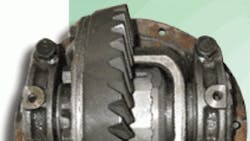Shims for preloading
Preload is the minimum amount of force that ensures smooth and tight movement between parts in a power-transmission assembly by eliminating gaps and slop. A myriad of mechanisms require preloaded connections: One classic example is angular roller and ball bearings that must remain axially engaged at all points of their working surfaces, despite the inevitable tolerance stackups of the assemblies in which they're installed.
An option for preloading is to wedge spacers or shims between mating parts. More specifically, edge-bonded shim sets are layered shims held together only by their edges to make it easier for production-line workers (or field technicians) to peel them to the required thickness.
This month's handy tips provided by Justin Singleton, field applications engineer, and Michael Morehouse, shims estimator, of SPIROL International Corp., Stow, Ohio. For more information or free samples, call (330) 920-3655 or visit spirol.com.
Q&A
What other methods are used to preload mechanisms?
Threaded stop nuts or bolts are sometimes used to preload assemblies. They provide infinitely adjustable preload and can be serviced in the field with minimal stocked parts. However, their amount of preload is limited by the nut's torque specification. Threaded systems are also relatively expensive. In contrast, edge-bonded shim sets provide more consistent preloading over a design's service life, without requiring a precise torque set.
Preloading with single-thickness shims involves displacing gaps during assembly. They're simple and inexpensive, and maintain constant preload between service intervals. However, end users must stock multiple thicknesses.
Preloading with conical, coil-compression, or wave springs depends on the spring constant K and is only adjustable by replacing the spring with one of a different strength or configuration; preload also dissipates as the spring fatigues. The simple design allows some yield during impact, which is helpful in some cases, but detrimental elsewhere, as in meshing ring-and-pinion gearsets. Preload force is also distributed on a circle — while edge-bonded shim sets can be manufactured in any shape.
How do these edge-bonded shims compare to those bonded on entire layer surfaces?
Surface-bonded shim sets, also called laminated shims, are glued together over their entire surfaces — between each layer of material. The layers are pressed together to cure, much like how particle board is manufactured. The design is simple and inexpensive, though more expensive than edge-bonded varieties; they also maintain constant preload between service intervals, and allow for easier use in the field with less parts stocking than using single-thickness shims. That said, sometimes it is difficult to peel layers, and discarded layers must be scrapped. In contrast, edge-bonded shim sets can be adjusted in seconds, without using a knife to remove the various layers.
How it works: Edge-bonded shim set layers are first pressed together, and then adhered by the edges of the shim's profile. This allows for much easier separation in the field. Furthermore, unused layers can be saved for future applications.
Are there other applications?
Yes. One military ground assault vehicle manufacturer uses adjustable shim packs for spacing of armored-vehicle door hinges, because spacing is critical to the doors' proper sealing and locking engagement. Using surface-bonded shims requires about 94 layers of 0.002-in. thick laminates — and the part size and configuration are too costly and complicated to adjust dimensionally. In contrast, edge-bonded shim sets perform better in this application, providing safe and tool-free adjustment and a 70% cost reduction — as well as shorter lead times.
